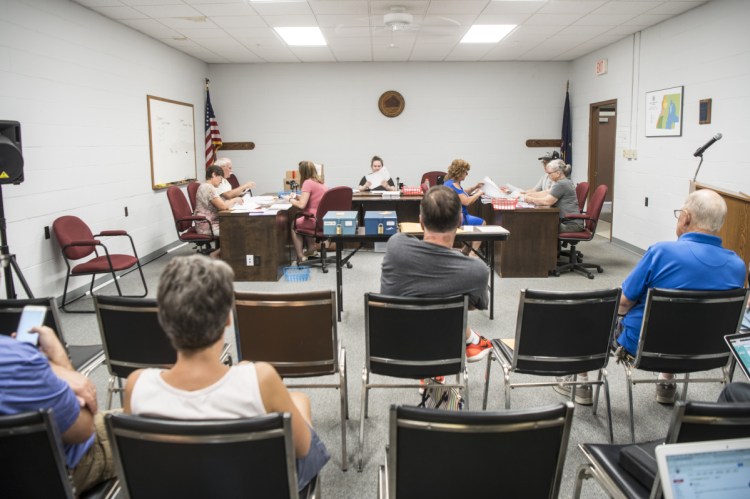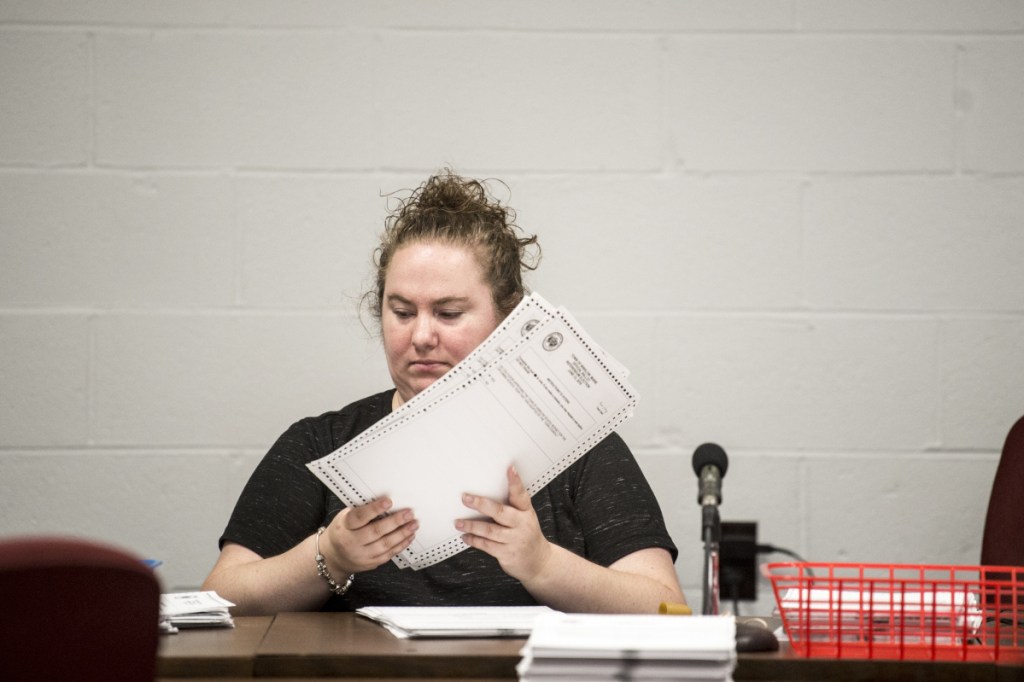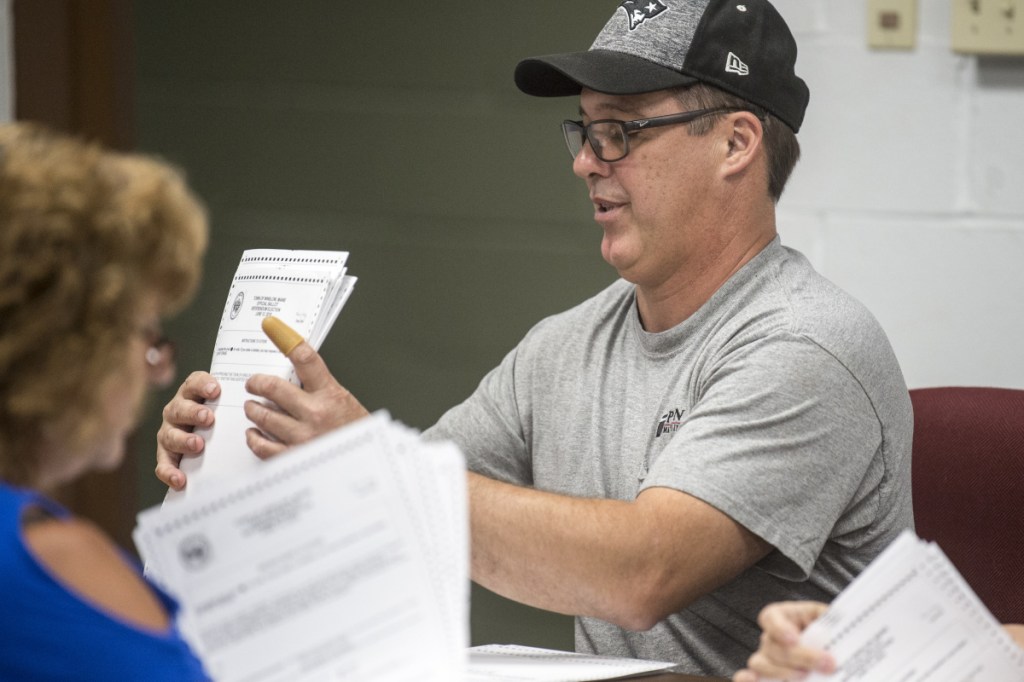WINSLOW — An election recount conducted Tuesday afternoon at the Town Office confirmed that the school renovation bond and the education budget referendums were indeed approved by voters in June. But one opponent of the bond project said there are still questions that need to be answered about a high number of ballots that were left blank.
The original count for the $8.1 million school bond was 881-825 in favor, with 194 blank votes; and for the $15.57 million budget, 1,140-719 in favor, with 41 blank votes. The tally was altered only slightly after Tuesday’s recount, with 882-828 in favor, with 192 blank votes, for the bond; and 1,143-725 in favor, with 34 blank votes, for the budget.
Tanya Godding, the town’s deputy clerk, said two additional uncounted votes were found in the envelope. All of the votes were counted by two teams of two made up of one representative each from the ‘yes’ camp and one from the ‘no.’ The teams counted stacks of 50 votes at a time, and both team members had to agree on the tally before moving on to another stack. Waterville clerks Patty Dubois and Sarah Cross monitored each team.
Phil St. Onge, who filed the petition to force the recount, and Kyle Price, the Winslow Elementary School principal, served as the representative for the ‘no’ and ‘yes’ camps, respectively. Both were able to review the ballots as well.
St. Onge has said previously that he didn’t think the recount would change the outcome of the vote, but it was the only way to review the blank ballots. The large number of blank ballots had concerned him and prompted him to launch the recount.
“We’re looking to find out what happened and why so many people left blank ballots,” St. Onge said. “From what I’ve found so far, typically (undervotes represent) about 2 or 3 percent (of the vote), so why was it over 10 percent of this particular issue? There’s a number of reasons that we’re exploring.”
While there was a large number of blank ballots, any ballot that was blank on one side in the machine was rejected and the clerk informed the voter that he or she left one side of the ballot blank, according to Town Manager Mike Heavener. The voter then was given the opportunity to take the ballot back to complete it. He said some took their ballots back and others did not. This occurred with both the state ballot and the municipal ballot.
The main questions St. Onge has concerning the blank ballots are why the budget and bond questions were printed on a double-sided ballot, why the education budget was printed on what he called the “front” of the ballot, and why election clerks put up a sign around noon to remind people to flip over their ballots.
“Why did they put two questions on different sides?” he asked. “They could have fit them on the same side of the ballot. We’ve proven that.”
St. Onge said he used Photoshop to prove that both questions could fit on the same side of the ballot.
He also asked why the education budget question was printed on what he referred to as the front of the ballot, which was a shorter question than the bond question. He said it would have made more sense to print the longer question on the front because it would be easier to see the words “turn over” at the bottom of the ballot.
Additionally, he questioned election officials’ decision to put a sign at noon that reminded people to turn over their ballots, and he wants to know how many blank ballots were turned in before noon.
“Something must have caused them to go, ‘Oh, we better put some signs up,'” he said.
St. Onge said he was not persuaded by the fact that voters were informed when they submitted an incomplete ballot and asked if they wanted to fill out the rest. He said he thinks people were confused when they filled out the ballot.
St. Onge plans to take the information gathered from the recount to his lawyers and see what they advise from there.
“I think those are all answers that the voters of Winslow have a right to hear,” he said. “They ought to have those questions answered.”
Heavener said after the recount that he doesn’t believe there are any grounds to overturn the budget or bond vote.
“Everybody had the same ballots, so if I took the time to complete the ballot, why should my vote not count?” he asked.
He said undervoting is very common and happens every election.
“I remember my first election, in ’06, when I helped at the polls, and I was shocked,” he said. “Not only were there undervotes where people voted on some things but not all of it, but there were some ballots that just were completely blank.”
He said you can’t draw a conclusion from undervotes and blank ballots. Some people were just not comfortable voting on the questions.
“Folks were asked if they wanted to complete the ballot and the clerks were told by some that, no, they intentionally left the ballot blank on the bond question,” he said. “They just weren’t comfortable voting on it.”
As for printing the two questions on a double-sided ballot, Heavener said it is perfectly appropriate to do.
“There is no front or back (to a ballot),” he said. “It’s like pulling someone over and asking them why are you doing the speed limit, right? There’s nothing wrong with doing a double-sided ballot. It’s legal. It’s appropriate.”
The sign to remind people to turn over their ballots was just another reminder for voters, Heavener said.
“That’s just being courteous,” he said.
Emily Higginbotham — 861-9239
ehigginbotham@centralmaine.com
Send questions/comments to the editors.





